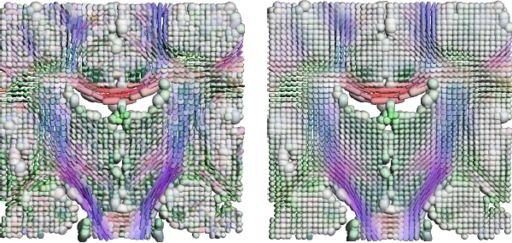Difference between revisions of "Projects:DTIProcessingTools"
From NAMIC Wiki
| (20 intermediate revisions by 3 users not shown) | |||
| Line 1: | Line 1: | ||
| − | Back to | + | Back to [[Algorithm:Utah|Utah Algorithms]] |
__NOTOC__ | __NOTOC__ | ||
= DTI Processing and Statistics Tools = | = DTI Processing and Statistics Tools = | ||
| + | |||
* ''Differential Geometry'' We will provide methods for computing geodesics and distances between diffusion tensors. Several different metrics will be made available, including a simple linear metric and also a symmetric space (curved) metric. These routines are the building blocks for the routines below. | * ''Differential Geometry'' We will provide methods for computing geodesics and distances between diffusion tensors. Several different metrics will be made available, including a simple linear metric and also a symmetric space (curved) metric. These routines are the building blocks for the routines below. | ||
| Line 14: | Line 15: | ||
|[[Image:DTIFiltering.jpg|thumb|512px|Coronal slice from a noisy DTI (left). The same slice after applying our Rician noise DTI filtering method (right).]] | |[[Image:DTIFiltering.jpg|thumb|512px|Coronal slice from a noisy DTI (left). The same slice after applying our Rician noise DTI filtering method (right).]] | ||
|} | |} | ||
| − | |||
| − | |||
| − | |||
| − | |||
| − | |||
| − | |||
| − | |||
| − | |||
= Description = | = Description = | ||
| Line 37: | Line 30: | ||
= Key Investigators = | = Key Investigators = | ||
| − | * Utah | + | * Utah: Tom Fletcher, Ran Tao, Saurav Basu, Sylvain Gouttard, Ross Whitaker |
= Publications = | = Publications = | ||
| − | * | + | * [http://www.na-mic.org/publications/pages/display?search=DTIProcessingTools NA-MIC Publications Database on DTI Processing and Statistics Tools] |
| + | |||
| + | = Software = | ||
| + | |||
| + | * [http://www.nitrc.org/projects/dtiricianrem| Slicer3 Command Line Module] | ||
| + | |||
| + | |||
| + | |||
| − | + | [[Category:Diffusion MRI]] [[Category:Statistics]] [[Category:Registration]] [[Category:Slicer]] | |
Latest revision as of 14:30, 14 May 2010
Home < Projects:DTIProcessingToolsBack to Utah Algorithms
DTI Processing and Statistics Tools
- Differential Geometry We will provide methods for computing geodesics and distances between diffusion tensors. Several different metrics will be made available, including a simple linear metric and also a symmetric space (curved) metric. These routines are the building blocks for the routines below.
- Statistics Given a collection of diffusion tensors, compute the average and covariance statistics. This can be done using the metrics and geometry routines above. A general method for testing differences between groups is planned. The hypothesis test also depends on the underlying geometry used.
- Interpolation Interpolation routines will be implemented as a weighted averaging of diffusion tensors in the metric framework. The metric may be chosen so that the interpolation preserves desired properties of the tensors, e.g., orientation, size, etc.
- Filtering We will provide anisotropic filtering of DTI using the full tensor data (as opposed to component-wise filtering). Filtering will also be able to use the different metrics, allowing control over what properties of the tensors are preserved in the smoothing. We have also developed methods for filtering the original diffusion weighted images (DWIs) that takes the Rician distribution of MR noise into account (see MICCAI 2006 paper below).
Description
- Developed a Slicer module for our DT-MRI Rician noise removal during the 2007 Project Half Week. Also enhanced the method by including an automatic method for determining the noise sigma in the image.
- Developed prototype of DTI geometry package. This includes an abstract class for computing distances and geodesics between tensors, while derived classes can specify the particular metric to use. Current implemented subclasses are the basic linear metric and the symmetric space metric.
- Developed prototype of DTI statistical package. A general class has been developed for computing averages and principal modes of variation of tensor data. The statistics class can use any of the metrics described above.
- We have begun work on a general method for hypothesis testing of differences in two diffusion tensor groups. This method works on the full six-dimensional tensor information, rather than derived measures. The hypothesis testing class can also use any of the different tensor metrics.
- Participated in the Programmer's Week (June 2005, Boston). During this week the DTI statistics code was developed and added to the NA-MIC toolkit. See our Progress Report (July 2005).
Key Investigators
- Utah: Tom Fletcher, Ran Tao, Saurav Basu, Sylvain Gouttard, Ross Whitaker
